Areas of Innovation

Areas of Innovation |

|
By T. Tuhinanshu |
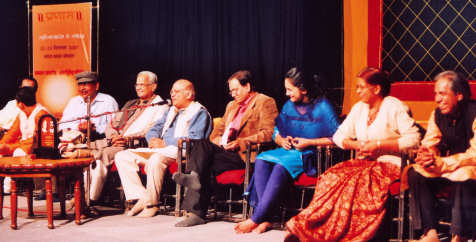
The capital of Madhya Pradesh, Bhopal is often the cultural capital of the state and on occasions it has sported international events as well. Madhukali's award ceremony was such a quiet unpretentious event that well may have started a new trend.  For the first time, awards dedicated to encourage young performers in the field of classical music and dance had been announced by a private organization in the state which accords several prestigious awards and honors to mature artistes like Tansen Samman, Kalidas Samman and Lata Mangeshkar Puruskar among others. With increasing focus on young achievers in almost every field, the practitioner of classical music are at a disadvantage when it comes to recognition. While it takes anything from a whole decade to even five or six for the artiste to master his music or dance in order to be recognized (Pt. Gokulotsav Maharaj was awarded Tansen Samman for 2007 at the age of sixty), a sixteen year old tennis player or a pop-singer out of teens gains an iconic stature. Pt. Lalmani Misra Kishor Adhyeta and Yuva Sadhak awards recognize the need for encouragement to youngsters devoting time and energy to the demanding discipline of Indian classical music.
For the first time, awards dedicated to encourage young performers in the field of classical music and dance had been announced by a private organization in the state which accords several prestigious awards and honors to mature artistes like Tansen Samman, Kalidas Samman and Lata Mangeshkar Puruskar among others. With increasing focus on young achievers in almost every field, the practitioner of classical music are at a disadvantage when it comes to recognition. While it takes anything from a whole decade to even five or six for the artiste to master his music or dance in order to be recognized (Pt. Gokulotsav Maharaj was awarded Tansen Samman for 2007 at the age of sixty), a sixteen year old tennis player or a pop-singer out of teens gains an iconic stature. Pt. Lalmani Misra Kishor Adhyeta and Yuva Sadhak awards recognize the need for encouragement to youngsters devoting time and energy to the demanding discipline of Indian classical music.
Instituting the awards to young performers was Madhukali's way to encourage practice of classical music; initiating determination of direction for its growth was Omenad's contribution. The symposium held at Bharat Bhawan on 23rd December focused on areas of innovation in Indian Classical Music, both in teaching and in practice. Speakers had selected one particular area out of Principles, Practice or Teaching. A couple of them could not attend the symposium personally but an abstract of their papers was included in the hand-outs. Each of the speaker attempted to connect the present state of music with the projected one in a logical manner. Despite a few repetitions (of facts relating to historical or contemporary situation) each of them pored over a unique aspect that found its place in the final solution.
The day started with an orchestral presentation on fifteen Sitar-s by students of Sarojini Naidu Girls College, Bhopal. 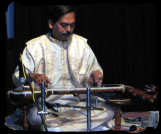 The composer-conductor, Dr. Sudha Dixit has been experimenting with collaborative presentation of Indian Raga-s for some years now. Later in the day she presented her paper on this theme. It was a treat to listen to so many Sitar-s together. As the chief guest Pt. Raghunath Seth lamented, large orchestra groups have been wiped away from film-music scenario because of modern recording technology. With greater part of film-music being created on synthesizers, the few real instruments used get recorded separately providing no satisfaction to the artiste. Film-music was the only supportive arena for orchestra in India. Though scholars like Dr. Lalmani Misra had continuously underlined the need for collaborative Indian music, suggesting formation of music-groups at city and town level like philharmonics in the West, this is yet to be. Even though the group-music kept alive by the film industry was commercial in nature and not liberal, has totally disappeared in the sub-continent. In an event being held in memory of the scholar-artiste, it was opportune that not only an orchestral presentation was being given but a new Veena too was unveiled on this occasion. Shri Niranjan Haldar played Desi on Ranjan Veena which sounded almost like Sitar but sported a range of Vichitra Veena. It is on portability that this modification scores over the earlier instrument. While it may take some time for the traditional audience to voice their acceptance, neo-learners acquainted with guitar would find this instrument handy in learning Indian classical music.
The composer-conductor, Dr. Sudha Dixit has been experimenting with collaborative presentation of Indian Raga-s for some years now. Later in the day she presented her paper on this theme. It was a treat to listen to so many Sitar-s together. As the chief guest Pt. Raghunath Seth lamented, large orchestra groups have been wiped away from film-music scenario because of modern recording technology. With greater part of film-music being created on synthesizers, the few real instruments used get recorded separately providing no satisfaction to the artiste. Film-music was the only supportive arena for orchestra in India. Though scholars like Dr. Lalmani Misra had continuously underlined the need for collaborative Indian music, suggesting formation of music-groups at city and town level like philharmonics in the West, this is yet to be. Even though the group-music kept alive by the film industry was commercial in nature and not liberal, has totally disappeared in the sub-continent. In an event being held in memory of the scholar-artiste, it was opportune that not only an orchestral presentation was being given but a new Veena too was unveiled on this occasion. Shri Niranjan Haldar played Desi on Ranjan Veena which sounded almost like Sitar but sported a range of Vichitra Veena. It is on portability that this modification scores over the earlier instrument. While it may take some time for the traditional audience to voice their acceptance, neo-learners acquainted with guitar would find this instrument handy in learning Indian classical music.
 Teaching of music appeared as major concern with increase in number of students, shortening of learning time, diversity in their geographical and cultural background and above all change in their learning attitude. Dr. Suwarna Wad drew attention to the four components of learning process -- pupil, teacher, teaching methodology and evaluation. Of the four it was teacher and teaching methodology that demanded attention. While music exists merely as hobby
Teaching of music appeared as major concern with increase in number of students, shortening of learning time, diversity in their geographical and cultural background and above all change in their learning attitude. Dr. Suwarna Wad drew attention to the four components of learning process -- pupil, teacher, teaching methodology and evaluation. Of the four it was teacher and teaching methodology that demanded attention. While music exists merely as hobby rather than a regular subject at school level, the music-teachers are not treated at par with others. She pointed out that while securing such essentials as dedication, respect and hard work that formed the basis of Guru-Shishya tradition of learning, a wider understanding of music should form the foundation of institutional learning. Dr. Abha Chourasiya concentrated upon the methodology to be adopted while teaching young learners. She felt that wider acceptance of classical music through appreciation courses would result in greater concentration of those studying it as discipline.
rather than a regular subject at school level, the music-teachers are not treated at par with others. She pointed out that while securing such essentials as dedication, respect and hard work that formed the basis of Guru-Shishya tradition of learning, a wider understanding of music should form the foundation of institutional learning. Dr. Abha Chourasiya concentrated upon the methodology to be adopted while teaching young learners. She felt that wider acceptance of classical music through appreciation courses would result in greater concentration of those studying it as discipline.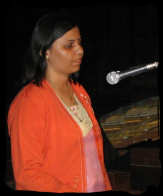 Divyata Jain advocated use of technology in the learning process. Practical lessons designed in small steps (notes, movement, alankar-s) followed by a lucid composition could be heard casually on a cassette / mp3 player as the pupil went about doing other things. Technology has also made a wide selection possible. This, pointed out Dr. Poonam Khare, is also one of the dangers faced by Indian classical music. Each Raga is complex as a mathematical theorem.
Divyata Jain advocated use of technology in the learning process. Practical lessons designed in small steps (notes, movement, alankar-s) followed by a lucid composition could be heard casually on a cassette / mp3 player as the pupil went about doing other things. Technology has also made a wide selection possible. This, pointed out Dr. Poonam Khare, is also one of the dangers faced by Indian classical music. Each Raga is complex as a mathematical theorem.  Before one can absorb it enough to recognize it, the presence of another is sure to cause confusion. Hence, it would be advisable to hear the same Raga performed by different artistes on different instruments rather than listen to different compositions of a single artiste. Dr. Khare also pointed out how relating music to everyday science shall facilitate its understanding.
Before one can absorb it enough to recognize it, the presence of another is sure to cause confusion. Hence, it would be advisable to hear the same Raga performed by different artistes on different instruments rather than listen to different compositions of a single artiste. Dr. Khare also pointed out how relating music to everyday science shall facilitate its understanding.
Dr. Praveeen Uddhav illustrated how various schools of Tabla should be recognized and mastered. He pointed out that if one understood the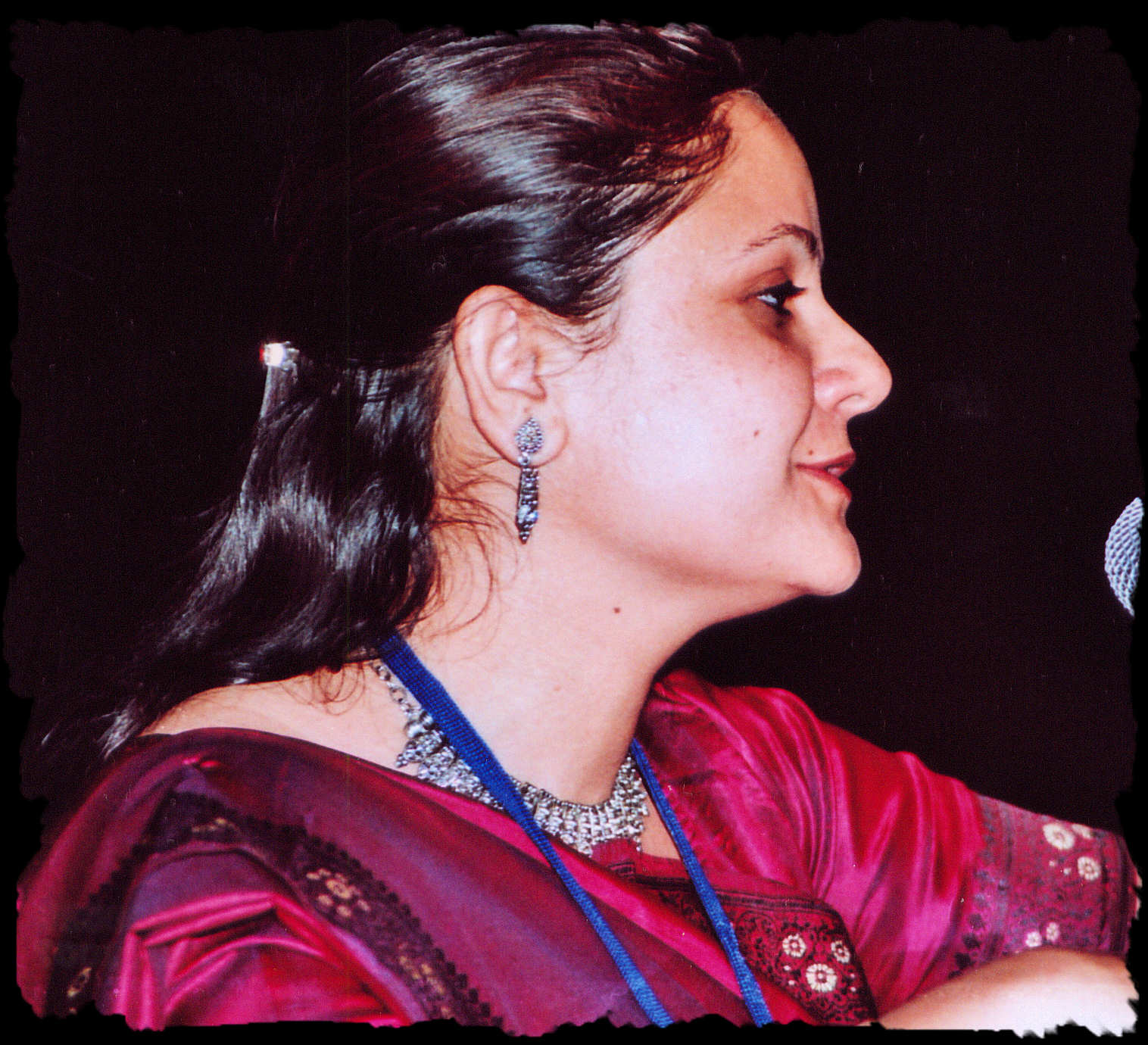 Nikas (the manner in which finger comes in contact with membrane) of a particular school, learning to play out the style would be quite easy. He also laid stress on the seating posture; incorrect posture often lead to severe ailments. Dr. Vidhi Nagar taking her cue from Dr. Uddhav laid emphasis on understanding things in a holistic manner. She demonstrated how the knowledge of Tabla helps a dancer modulate his or her movements with just the right force.
Nikas (the manner in which finger comes in contact with membrane) of a particular school, learning to play out the style would be quite easy. He also laid stress on the seating posture; incorrect posture often lead to severe ailments. Dr. Vidhi Nagar taking her cue from Dr. Uddhav laid emphasis on understanding things in a holistic manner. She demonstrated how the knowledge of Tabla helps a dancer modulate his or her movements with just the right force.
While the traditional learner faces a number of problems in learning Indian Classical music, there is a new breed of learners that comes to this genre with great passion but little cultural understanding.  Dario Israri focused upon the stumbling blocks that pose a great challenge for a western learner. Apart from the difference in western and Indian notes and the strangeness of a fixed shadja against fixed frequency it is more the traditions, customs and practices of Indian musicians that bewilder the western learner. When an Indian musician personifies a Raga, he does it in the long tradition of Bhakti -- one-to-one relationship with one's God. Western mind is not given to such duality of fantasy and realism. There is a great chasm between rational, fixed meaning allotted to notions like respect, devotion, acceptance by the modern western mind and fluid, contradictory ones by the oriental mind.
Dario Israri focused upon the stumbling blocks that pose a great challenge for a western learner. Apart from the difference in western and Indian notes and the strangeness of a fixed shadja against fixed frequency it is more the traditions, customs and practices of Indian musicians that bewilder the western learner. When an Indian musician personifies a Raga, he does it in the long tradition of Bhakti -- one-to-one relationship with one's God. Western mind is not given to such duality of fantasy and realism. There is a great chasm between rational, fixed meaning allotted to notions like respect, devotion, acceptance by the modern western mind and fluid, contradictory ones by the oriental mind. 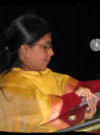 It is not same when a western pupil bows down to his instrument before picking it up to perform. Dr. Vibha Chourasiya dealt with these among other problems faced by contemporary western learners and projected ones that shall deter future learners if not corrected in time. In future, learners of mature age would turn to music. Many of them would be naturally talented and all of them would be share a passion for music. Such learners would require a fast-paced introduction to theoretical aspect with practical exercises that satisfies their intellectual curiosity. Themselves an expert in their own field these pupils would require exhaustive knowledge on the part of teacher. However, distinction would have to be made between the serious and casual learners. For each kind short syllabi of six month duration should be developed in which they learn one or two Raga-s through alankar, bhajan and short compositions.
It is not same when a western pupil bows down to his instrument before picking it up to perform. Dr. Vibha Chourasiya dealt with these among other problems faced by contemporary western learners and projected ones that shall deter future learners if not corrected in time. In future, learners of mature age would turn to music. Many of them would be naturally talented and all of them would be share a passion for music. Such learners would require a fast-paced introduction to theoretical aspect with practical exercises that satisfies their intellectual curiosity. Themselves an expert in their own field these pupils would require exhaustive knowledge on the part of teacher. However, distinction would have to be made between the serious and casual learners. For each kind short syllabi of six month duration should be developed in which they learn one or two Raga-s through alankar, bhajan and short compositions.
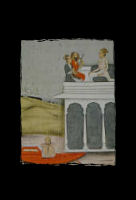 Indian music developed in strict accordance with aesthetic principles explained in Natyashastra. Art and Iconography had been discussed in earlier treatises like Matsya Purana, Brihat Samhita, Varah Purana, Agni Purana etc. but Vishnudharmottara Purana has dedicated sections for iconography and painting with some parts dateable from 5th to 6th century A.D. Indian society had always laid great stress on Samskara or inherited values.
Indian music developed in strict accordance with aesthetic principles explained in Natyashastra. Art and Iconography had been discussed in earlier treatises like Matsya Purana, Brihat Samhita, Varah Purana, Agni Purana etc. but Vishnudharmottara Purana has dedicated sections for iconography and painting with some parts dateable from 5th to 6th century A.D. Indian society had always laid great stress on Samskara or inherited values.  Dr. Naval Krishna, noted art-historian argued that holistic development contributes to superior learning than isolated honing of skill. A quick survey of Ragamala paintings elicits that there has been a tradition of linkage between visual and aural representation. One set of Ragmala paintings from 17th century Maharana of Mewar from Udaipur, reflecting admixture of Deccani and Rajasthani style documents twenty-one Raga-s from Vasant, Vibhas and Vilaval to Khambawati, Madhumadhavi and Gund Malhar 1. Even a lay viewer can make association between the between and the Raga. This may be discernible to learned in some cases; yet the linkage is undeniable. A modern student can never find the essence of Indian music until he imbibes the spirit of this ancient nation.
Dr. Naval Krishna, noted art-historian argued that holistic development contributes to superior learning than isolated honing of skill. A quick survey of Ragamala paintings elicits that there has been a tradition of linkage between visual and aural representation. One set of Ragmala paintings from 17th century Maharana of Mewar from Udaipur, reflecting admixture of Deccani and Rajasthani style documents twenty-one Raga-s from Vasant, Vibhas and Vilaval to Khambawati, Madhumadhavi and Gund Malhar 1. Even a lay viewer can make association between the between and the Raga. This may be discernible to learned in some cases; yet the linkage is undeniable. A modern student can never find the essence of Indian music until he imbibes the spirit of this ancient nation.
"Raga is a Sanskrit word that has umpteen shades of meaning – from love, affection, desire and infatuation to entertainment, pursuit, disposition, poetry and music." Even in the strict domain of musical notes, it gives rise to mystery.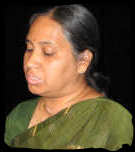 The same movement of notes depending on which notes it starts from gives rise to a different Raga. It is astounding how despite restrictions, the same set of notes can be played or sung by different artistes in unique manner. More than that, even when an artiste plays the Raga repeatedly, he may sound different each time. But, pointed out Dr. Bageshri Joshi, far more enchanting is the problem of how an artiste converses with a set of notes. Mystery lies in mutual affinity between notes. They affect an artiste in four ways when he tires to unravel their secret -- with their wayward abandon, with their complex interweave, with their clarity and calmth, with their adornment or orientation. She referred to Kumar Gandharva's response to the charge of deflecting from norm, "I do not invite that note. It begs to me... grovels that I should use it if only once... When I get moved by its prayers, I do use it at times." A vocal performance employs both words and sound movement. The word represents the external visage of the Raga while the movement signifies its essence. As they co-exist they may affect different people differently. Some scholars consider for this reason alone that music in itself is devoid of any emotions.
The same movement of notes depending on which notes it starts from gives rise to a different Raga. It is astounding how despite restrictions, the same set of notes can be played or sung by different artistes in unique manner. More than that, even when an artiste plays the Raga repeatedly, he may sound different each time. But, pointed out Dr. Bageshri Joshi, far more enchanting is the problem of how an artiste converses with a set of notes. Mystery lies in mutual affinity between notes. They affect an artiste in four ways when he tires to unravel their secret -- with their wayward abandon, with their complex interweave, with their clarity and calmth, with their adornment or orientation. She referred to Kumar Gandharva's response to the charge of deflecting from norm, "I do not invite that note. It begs to me... grovels that I should use it if only once... When I get moved by its prayers, I do use it at times." A vocal performance employs both words and sound movement. The word represents the external visage of the Raga while the movement signifies its essence. As they co-exist they may affect different people differently. Some scholars consider for this reason alone that music in itself is devoid of any emotions.
If the same performance affects two individuals differently depending on the state of their minds, how can a Raga be prescribed as remedy for an ailment or disease? 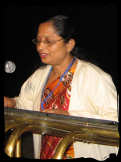 Dr. Sharada Velankar examined the claims of proponents of music therapy. She reasoned that first of all the effect of sound on human body has to be empirically studied. She accepted that music has always appealed to mind -- manah (mind) + ranjan (joy, appeasement). But despite its capabilities to soothe and calm an agitated mind, therapy is too far-fetched a word for its effect on human beings. Often the style of presentation of any given composition (a fixed expression of the fluid, tameless Raga) varies between schools, artistes and even two performances. When the sound itself can not be presented in a quantifiable manner through live performance, the alternative is to look for mechanical repetition of the same sound. As it affects first the mind and then only (if at all) other parts of body, receptivity of music being subjective, there is no certitude that it shall affect two persons in the same manner. Music has been traditionally employed in temples, festivities and even on battlefields. Bharat himself speaks of use of music in boosting the nav-rasa. However, use of classical music as therapy requires far deeper study than is needed merely to preserve it in its traditional form. Classical music like all other art-forms is endangered because people are constantly falling short of time. Branding it as therapy is adding insult to injury. Dr. Sudha Dixit agreed with 'shortage of time' being the prime threat to preservation of Indian classical music. She suggested that as market forces drive out the variety of Indian music due law of volumes,
Dr. Sharada Velankar examined the claims of proponents of music therapy. She reasoned that first of all the effect of sound on human body has to be empirically studied. She accepted that music has always appealed to mind -- manah (mind) + ranjan (joy, appeasement). But despite its capabilities to soothe and calm an agitated mind, therapy is too far-fetched a word for its effect on human beings. Often the style of presentation of any given composition (a fixed expression of the fluid, tameless Raga) varies between schools, artistes and even two performances. When the sound itself can not be presented in a quantifiable manner through live performance, the alternative is to look for mechanical repetition of the same sound. As it affects first the mind and then only (if at all) other parts of body, receptivity of music being subjective, there is no certitude that it shall affect two persons in the same manner. Music has been traditionally employed in temples, festivities and even on battlefields. Bharat himself speaks of use of music in boosting the nav-rasa. However, use of classical music as therapy requires far deeper study than is needed merely to preserve it in its traditional form. Classical music like all other art-forms is endangered because people are constantly falling short of time. Branding it as therapy is adding insult to injury. Dr. Sudha Dixit agreed with 'shortage of time' being the prime threat to preservation of Indian classical music. She suggested that as market forces drive out the variety of Indian music due law of volumes,  it is necessary to preserve the lesser known Raga-s as well. As mastering indian music requires a great deal of time, energy and patience, even musically oriented persons too opt out. If these talented persons are provided a way to satisfy their musical interests without too much demand on their time, it shall serve man and music both. She narrated her experience of using collaborative presentation to preserve difficult and rarely practiced Raga-s. Initially, student orchestra groups would be able to present the bare-bone Raga but later as a sophisticated group develops, they would be able to play out such Raga-s in their entirety. She has been experimenting with under-graduate students. The learning curve is sharp and a fresh group (students who have learnt Sitar for one year) can catch and present a new fifteen minute commotion in eight to ten hour-long sessions. Girls move out of town after marriage and when they meet their mentor years later they lament the lack of an orchestra group in their city. It is such enthusiasts who can be served through choral and orchestral groups at town level. As some of them study music as a subject even if for three years during graduation, they can read and practice compositions in privacy of their homes and fulfill their artistic aspiration by participating in public performances.
it is necessary to preserve the lesser known Raga-s as well. As mastering indian music requires a great deal of time, energy and patience, even musically oriented persons too opt out. If these talented persons are provided a way to satisfy their musical interests without too much demand on their time, it shall serve man and music both. She narrated her experience of using collaborative presentation to preserve difficult and rarely practiced Raga-s. Initially, student orchestra groups would be able to present the bare-bone Raga but later as a sophisticated group develops, they would be able to play out such Raga-s in their entirety. She has been experimenting with under-graduate students. The learning curve is sharp and a fresh group (students who have learnt Sitar for one year) can catch and present a new fifteen minute commotion in eight to ten hour-long sessions. Girls move out of town after marriage and when they meet their mentor years later they lament the lack of an orchestra group in their city. It is such enthusiasts who can be served through choral and orchestral groups at town level. As some of them study music as a subject even if for three years during graduation, they can read and practice compositions in privacy of their homes and fulfill their artistic aspiration by participating in public performances.
Even though over a century and half has passed since western musicians and scholars began researching the Indian music system, a notation system that serves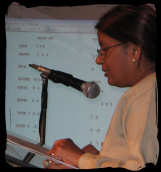 the need of Indian music is still to universally accepted. Pt. Vishnu Narayan Bhatkhande designed a system that has been accepted by Indian musicians. When they try to use it in scripts other than Devnagari or allied Indian ones, it becomes unmanageable. Pt. Omkar Nath Thakur surmounted this difficulty by ordaining each beat its unique grid along with some other symbols but unfortunately this could not gain popularity. Dr. Ragini Trivedi poring over the puzzle of universal acceptability vis-a-vis accurate representation hit upon an idea which simplifies the problem. She decided to use symbols independent of any linguistic script. These symbols (which have now been translated as glyphs in a specially designed font-system) are easy to learn, distinguish and use. She experimented with a group of students who after single exposure began taking down compositions written using this set. As Indian music involves signs for Kan, Gamak, Meend etc. using symbols instead of alphabets is easy, simple and yields high communicability.
the need of Indian music is still to universally accepted. Pt. Vishnu Narayan Bhatkhande designed a system that has been accepted by Indian musicians. When they try to use it in scripts other than Devnagari or allied Indian ones, it becomes unmanageable. Pt. Omkar Nath Thakur surmounted this difficulty by ordaining each beat its unique grid along with some other symbols but unfortunately this could not gain popularity. Dr. Ragini Trivedi poring over the puzzle of universal acceptability vis-a-vis accurate representation hit upon an idea which simplifies the problem. She decided to use symbols independent of any linguistic script. These symbols (which have now been translated as glyphs in a specially designed font-system) are easy to learn, distinguish and use. She experimented with a group of students who after single exposure began taking down compositions written using this set. As Indian music involves signs for Kan, Gamak, Meend etc. using symbols instead of alphabets is easy, simple and yields high communicability.
The first symbol, a circle represents Shadja out of which all other notes take form, the second is Rishabh, followed by Gandhar, Madhyam, Pancham and Dhaivat. Gandhar and Pancham are mirror images of each other as are Madhyam and Nishad.

The flat notes, Rishabh, Gandhar, Dhaivat and Nishad are indicated by underlining the notes while the only sharp note, Madhyam![]() carries a vertical bar.
carries a vertical bar.
![]()
Dr. Suneera Kasliwal discussed the possibilities of variation in presentation. On one hand the style of presentation goes on changing from one generation of artistes to next; 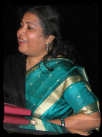 however, certain fundamentals remain unchanged. In catering to the present requirement of shorter presentations, artistes generally fail to capture the essence of Indian music. Technology influenced presentation twice in past two centuries. First, with printing press, Indian compositions could be written down and next with gramophone when a performance could be recorded. Broadcasting largely put a check on presentation by demanding them to fit within a slot of thirty minutes. Yet, artistes like Pt. Mallikarjun Mansur and Pt. Ravishankar could present Raga-s with clarity in as short duration as three minutes. Presentation time matters little if sufficient time has been devoted to learning. Indian classical music suffers more from hurried, selective learning than from shortening of presentations.
however, certain fundamentals remain unchanged. In catering to the present requirement of shorter presentations, artistes generally fail to capture the essence of Indian music. Technology influenced presentation twice in past two centuries. First, with printing press, Indian compositions could be written down and next with gramophone when a performance could be recorded. Broadcasting largely put a check on presentation by demanding them to fit within a slot of thirty minutes. Yet, artistes like Pt. Mallikarjun Mansur and Pt. Ravishankar could present Raga-s with clarity in as short duration as three minutes. Presentation time matters little if sufficient time has been devoted to learning. Indian classical music suffers more from hurried, selective learning than from shortening of presentations.
Every artiste knows that medium and expression influence each other. A well-loved painter of Indore, Vishnu Chinchalkar enjoyed 'art out of waste'. He confessed that for long he would sit holding the piece he had selected from waste material and then all of a sudden, find a suitable piece for the final form. Content declares the form, he believed. Dr. Santosh Pathak examined this hypothesis with regard to musical instruments and compositions commonly used by artistes. An instrumentalist influenced by Khayal or Dhrupad tends to move towards Gayaki ang, albeit in different ways. Mature artistes graduate towards an instrument different from one they started with.
The best reception by the audience was given to Mr. G. Rajanarayan's narration of the history of electronic musical instruments. An electronics engineer from IIT Chennai and 'A' 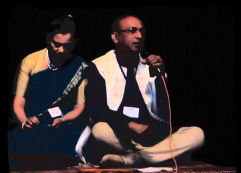
Some of the speakers could not make it though their abstracts were included in the hand-outs. The audience query regarding Omenad CD included in delegates' pack could not be addressed due paucity of time. They were also eager to acquire copies of the books on display. Chairperson of Madhukali, Dr. Kiran Deshpande had earlier informed them about the latest book of Prof R.C. Mehta. Organizers should have prepared a leaflet carrying publishers' addresses along with those of scholars. All said and done, the symposium held on eve of a new year (seven years after one on Distance Education in Music) at Bharat Bhawan Bhopal indicates that though the coming years may be turbulent, scholar-musicians are ready to steady the boat of Indian classical music.
References:
1Topsfield, Andrew. A Dispersed Ragmala from Deccan in The Anand Van of Indian Art. p. 322
The papers presented at this symposium have been compiled and published as Bharatiya Shastriya Sangeet: Shastra, Shikshan Va Prayog.
Academic Conventions
International Conference Jan 2009
'Africa Meets Asia' -- International Conference
"Music in Perspective of Globalization" Delhi March 2009
Other Concerts :
4th Brahaspati Sangeet Samaroh at Chandigarh
Reviews
Ilyas Khan. Sitar
Devotion. Sitar
Meditative Morn. Santoor
Artistes of Indore